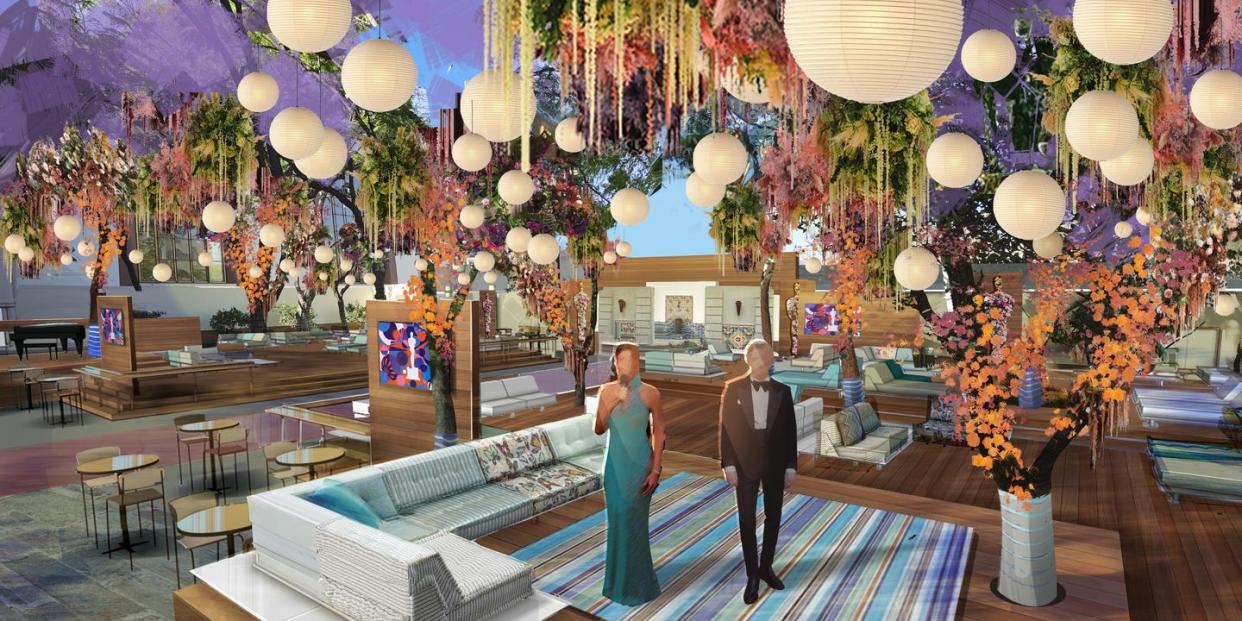How This Year's Oscars Ceremony Was Designed

- Oops!Something went wrong.Please try again later.
As with all pandemic-era events, the 93rd Academy Awards are going to look a little different than usual. At the helm as production designer, David Rockwell is doing his best to ensure the night is full of cinematic magic. It's a role reprisal for the award-winning architect and set designer, who also did the Oscars' sets in 2009 and 2010. (He's also an author; his new book Drama is out May 5.)
Rockwell says that from the start, he and the producers agreed that this was a major “pivot year” for the event–in terms of size, but also in tone and aesthetic.
“We started from scratch, asking how do we create a way to have this be smaller, have it be about the nominees, and invite the TV audience into a chance to celebrate this very creative, vital world of telling stories,” Rockwell says.
He went back to basics, looking to the ceremony’s 1929 origins. The first few Oscars ceremonies were intimate affairs, small dinner parties that were really about the gathering of nominees. After a year of turmoil and isolation, he says this year's event is “a statement about craving shared experience.”
Knowing that a traditional theater wouldn’t be ideal for the new, restriction-impacted show, Rockwell and his team explored alternative venue options. He wanted a location with a rich history, somewhere that would lend itself to an intimate setting, he says. They needed something else, too: space. For both design aesthetic and social distancing, the new venue would need to have major scale. Enter Union Station, an expansive (and iconic) railroad terminal built in 1939.
But Union Station was, in fact, built to be a train station, not a space for live performances, meaning Rockwell had to start from scratch to build his set. Further complicating the matter was the station’s landmark status, which meant that no lighting or sound equipment could be fixed to the ceilings or floors. Pandemic and landmark restrictions weren’t enough to faze Rockwell’s team, who engineered a self-contained set while accounting for all social distancing measures.

To establish a cozy space where nominees can come together while safely staying apart, Rockwell plans to use the station’s ticket hall to create a room within a room. A custom screen will enclose the staging and seating area, giving the effect of an inner room while allowing the architecture of the spacious original structure to be seen through the screen. “Intimacy is only visible in relation to scale, or it feels cramped,” he says.
Aesthetically, Rockwell says he drew inspiration from Union Station’s mashup of Art Deco and mission revival styles. All of the station’s spaces will be utilized, including two outdoor courtyards. There will be DJ spaces for QuestLove, who’s in charge of the night’s music. Outside, patios with seating, bars and tables will be spread out under a “woven ceiling of flowers” that Rockwell created with local florists. Nominees and their guests can lounge on the featured Mah Jong outdoor sofas from designer furnishers Roche Bobois, who told T&C that they were “ecstatic” to be involved.
What does Rockwell consider his metric for success? Is there one? “It’s an inherently ephemeral medium,” he says. If this year’s Oscars creates a lasting memory for both attendees and viewers, that would mean he did his job well, he says.
The 93rd annual Academy Awards will air live on ABC this Sunday, April 25 at 8 p.m. ET.
You Might Also Like

